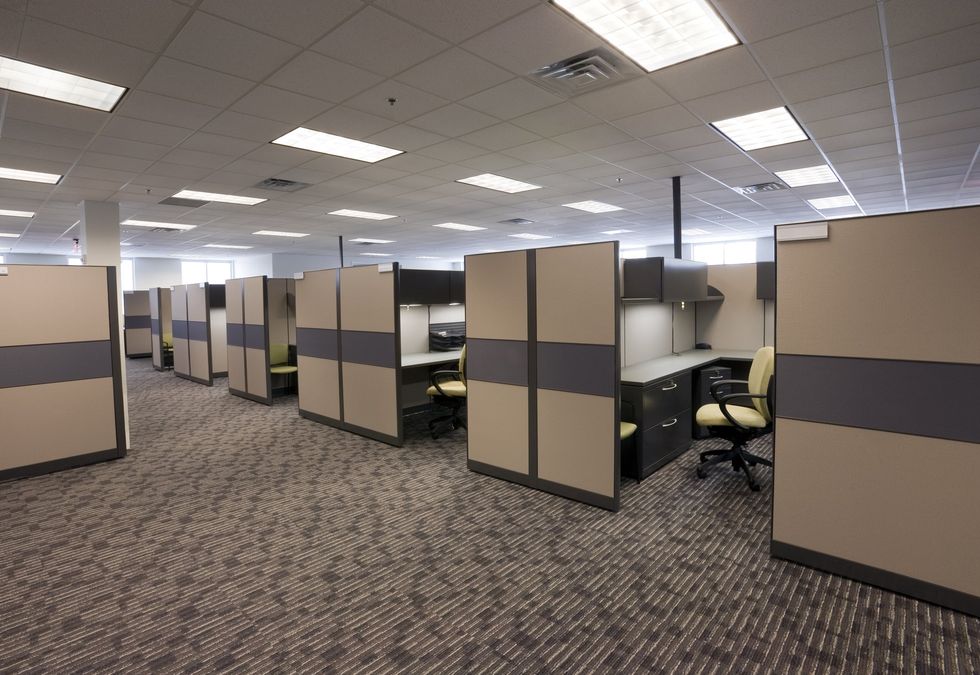It seems hard to remember Generation X as a media object unto itself like the Millennials were until recently, but Gen X tastes did leave their mark on history. Imagine Henry Rollins walking into a cubicle-sea office floor and shouting, “Open your eyes! The suits are just trying to control us and this is their rat maze, man! We’re just going about our days like drones in a hive!”
This caricature isn’t far from the real ethos of the 1990s. “Generation X” was coined in the 1991 novel “Generation X: Tales for an Accelerated Culture” by Douglas Coupland. Here’s a passage from one chapter named “I Am Not a Target Market”:
At the slightest provocation I’d have been willing to apologize for my working life – how I work from eight till five in front of a sperm-dissolving VDT performing abstract tasks that indirectly enslave the Third World. But then, hey! Come five o’clock, I’d go nuts! I’d streak my hair and drink beer brewed in Kenya. I’d wear bow ties and listen to alternative rock and slum in the arty part of town.
This international best-seller really did carry the voice of its generation, with detachment and a thirst for authenticity dripping from everything down to the chapter title. Another passage, with emphasis added, makes explicit the Gen X antipathy toward the cubicle:
I begin at the point where he once told me how he was at work and suffering from a case of “Sick Building Syndrome,” saying, “The windows in the office building where I worked didn’t open that morning, and I was sitting in my cubicle, affectionately named the veal-fattening pen. I was getting sicker and more headachy by the minute as the airborne stew of office toxins and viruses recirculated — around and around — in the fans.
Such “Fight Club”–stylerebellions against “wearing a tie” and other explicit symbolic conventions of hierarchy were discredited as soon as they won the cultural battle. Cubicles and neckties lost their cachet among the most cutting-edge Silicon Valley startups, which by necessity needed to make do with industrial lofts, which invited a seemingly egalitarian open-plan layout where executives would mingle with the rank and file. Nothing was exclusive or private — which, again, is downstream from the organizational reality of startups where every employee is performing the duties of several roles.
The office reimagined

It became clear that the anti-cubicle rebels had succeeded with their revolution in 2005, when Google redesigned its headquarters in the open-office format. This inspired a wave of cargo-cult imitators who wanted to at least appear to be as innovative as Google. The trend perhaps peaked in 2015 when Facebook built the world’s largest open-plan floor designed to fit 2,800 employees. By that time, 70% of offices in the United States followed an open plan. The language of “collaboration” and “openness” underpinned ubiquitous philosophical reasoning behind open-plan offices, echoing Frank Lloyd Wright’s justification for his 1939 Johnson Wax Headquarters that averted “fascist and totalitarian” tendencies by virtue of its open layout.
As soon as the open-plan office came to define a generation, the numbers started calling it into question, utopian justifications be damned. A 2013 study concluded that workers in open-office environments become frustrated by distractions that led to poorer work performance. Nearly half of the surveyed workers in open offices said the lack of sound privacy was a significant problem for them, and more than 30% complained about the lack of visual privacy. Meanwhile, the ease of interaction with coworkers was found not to be a problem in any type of office, and in fact, those with private offices were least likely to identify their ability to communicate with colleagues as a problem. A 2009 meta-analysis of literature on barrier-free office design found that such designs resulted in lower job satisfaction, higher blood pressure, increased turnover, and lower productivity.
Cubicles, it turns out, were a way to fix these rather obvious problems in the first place, and their drawbacks seem to be aesthetic complaints about the conformity of being confined to identical boxes under fluorescent light rather than a substantive criticism of corporate hierarchy. A boss without a tie still has the power to order you around and fire you, and an open office can easily be a panopticon without space for reflection or autonomy. Tech giants take open offices a step farther by filling their campuses with utopian-seeming amenities — foosball tables, laundry services, swimming pools — that are actually designed to muddle the work-life distinction and prevent workers from leaving.
By the mid-2010s, the open office had acquired the hated role that cubicles occupied in the 1990s, perhaps with a little more saccharine sugarcoating sprinkled on top. A 2014 article from the Washington Post criticizing the open office sums up that era’s exhaustion with the trend. But the piece makes an ominous endorsement of a new kind of white-collar utopia:
On the other hand, companies could simply join another trend — allowing employees to work from home. That model has proven to boost productivity, with employees working more hours and taking fewer breaks. On top of that, there are fewer interruptions when employees work remotely. At home, my greatest distraction is the refrigerator.
This reads like a naive horror-movie protagonist setting up the audience for a sequel. And it kind of is. Just like at the tech campuses where hundreds of thousands of workers escaped for the comforts of home, the work-life balance was blurred. Your place of leisure becomes a productivity tomb that you never escape by schedule but only by intention.
For everyone else, the dream of remote work met its consummation in a compromise: You can live in the city of your choice, but one corner of your one-bedroom is your work life and the other corner is your life’s work.
Everyone who loves remote work is one of two types of person. The first are the nomads, who have the superhuman capacity to be productive while hunched over their laptops at a tiny table in any given cafe. The second are the outer suburbanites, who have the space needed for a home office and all the buffer space required to maintain the home as a place for family and leisure. In their very different ways, both are content to live their lives alone.
For everyone else, the dream of remote work met its consummation in a compromise: You can live in the city of your choice, but one corner of your one-bedroom is your work life and the other corner is your life’s work. There is no space, figurative or literal, between home as office and home as rest. One of the pieces of wisdom gleaned from the COVID era is that people actually like being around each other, including the people you share your productive life with.
But only having colleagues embodied as video calls sucks, just like being alone in the same space all day sucks. And like many things that suck, a world where everyone works from an electronic cubicle was a utopia anticipated by visionaries. Management guru Peter Drucker said in 1993 that “commuting to office work is obsolete,” an early declaration of the digital age’s dream of doing the job from a ski lodge or a Sicilian beach. But this is just a series of white-collar workers pining for something else.
Source: TheBlaze









